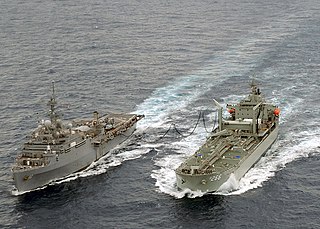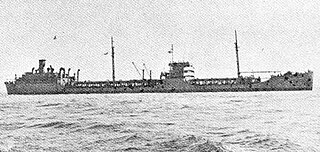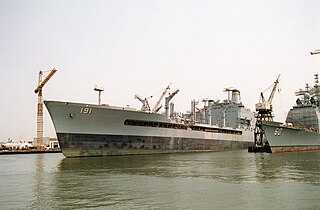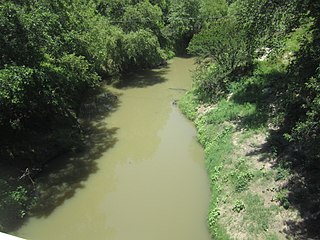This page is based on this
Wikipedia article Text is available under the
CC BY-SA 4.0 license; additional terms may apply.
Images, videos and audio are available under their respective licenses.
Guadalupe or Guadeloupe may refer to:

USS Ponchatoula (AO-148) was one of six Neosho-class fleet oilers built for the United States Navy, in service from 1956 to 1992, and named for the Ponchatoula Creek which rises in Tangipahoa Parish, Louisiana, and flows into the Natalbany River, west of Ponchatoula, Louisiana. She was the second U.S. Naval vessel to bear the name.

A replenishment oiler or replenishment tanker is a naval auxiliary ship with fuel tanks and dry cargo holds which can supply both fuel and dry stores during underway replenishment (UNREP) at sea. Many countries have used replenishment oilers.

USS Guadalupe (AO-32), a Cimarron-class fleet replenishment oiler that served in the United States Navy,it was named for the Guadalupe River in Texas.

The Henry J. Kaiser class is an American class of eighteen fleet replenishment oilers which began construction in August 1984. The class comprises fifteen oilers which are operated by Military Sealift Command to provide underway replenishment of fuel to United States Navy combat ships and jet fuel for aircraft aboard aircraft carriers at sea. One ship, operated by the United States from 1987 to 1996, was sold to Chile in 2009 and commissioned into the Chilean Navy in 2010; and two ships were scrapped in 2011 while still incomplete.

The Cimarron-class oilers were an underway replenishment class of oil tankers which were first built in 1939 as "National Defense Tankers," United States Maritime Commission Type T3-S2-A1, designed "to conform to the approved characteristics for naval auxiliaries in speed, radius and structural strength", anticipating their militarization in the event of war. "Tentative plans had been reached with the Standard Oil Company of New Jersey to build ten high-speed tankers with the government paying the cost of the larger engines needed for increased speed. By the first week in December [1937], Standard Oil had solicited and received bids from a number of yards providing for the construction of a number of 16,300-ton (deadweight) capacity tankers. Bids were requested for two versions: a single-screw design of 13 knots and a twin-screw design of 18 knots. The price difference between the two would be used to establish the government's cost subsidy for greater speed. Plans and specifications for both designs were prepared for Standard Oil by naval architect E. L. Stewart. It seems certain that the design for the 18-knot tanker evolved out of the bureau's (C&R) design for a fleet oiler."

SS Mission Santa Ynez was a Type T2-SE-A2 tanker built for the United States Maritime Commission during World War II. After the war she was acquired by the United States Navy as USS Mission Santa Ynez (AO-134). Later the tanker transferred to the Military Sea Transportation Service as USNS Mission Santa Ynez (T-AO-134). A Mission Buenaventura-class oiler, she was named for Mission Santa Inés located in Solvang, California.
USS Anacostia (AO-94) was a Escambia-class replenishment oiler acquired by the United States Navy for use during World War II. She had the dangerous but necessary task of providing fuel to vessels in combat and non-combat areas. She served in the Pacific Ocean Theater of operations late in the war, and returned home proudly with one battle star.

USS Caloosahatchee (AO-98) was a Cimarron-class fleet oiler constructed for the U.S. Navy for use in World War II but commissioned too late for service in that conflict. However, she had a lengthy career during the Cold War that followed. She was the only U.S. Navy ship to bear the name Caloosahatchee, after the Caloosahatchee River in southwest Florida.

USS Neosho (AO-143) was the lead ship of her class of fleet oilers of the United States Navy, in service from 1954 to the early 1990s.

USS Mississinewa (AO-144) was a Neosho-class fleet oiler of the United States Navy in service from 1955 to the early 1990s.

United States Naval Ship USNS Henry Eckford (T-AO-192) was a Henry J. Kaiser-class fleet replenishment oiler of the United States Navy. She was never completed.

USS Passumpsic (AO-107), the only United States Navy ship to bear the name, was an Ashtabula-class fleet replenishment oiler that served in the U.S. Navy from 1946 to 1973, then transferred to the Military Sealift Command to continue service as United States Naval Ship USNS Passumpsic (T-AO-107). She was the only U.S. Navy ship to bear the name Passumpsic, after the Passumpsic River in Vermont.

United States Naval Ship USNS Kanawha (T-AO-196) is a Henry J. Kaiser-class fleet replenishment oiler of the United States Navy in non-commissioned service in the Military Sealift Command.

United States Naval Ship USNS Benjamin Isherwood (T-AO-191) was a Henry J. Kaiser class fleet replenishment oiler of the United States Navy. She was never completed.

The T3 tanker, or T3, are a class of sea worthy large tanker ships produced in the United States and used to transport fuel oil, gasoline or diesel before and during World War II, the Korean War and the Vietnam War. The T3 tanker classification is still used today. The T3 tanker has a full load displacement of about 24,830 tons.















